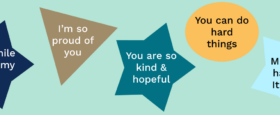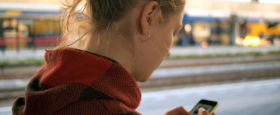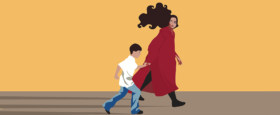5 mindfulness exercises for children (and) adults
Everyone needs to relax now and again. This applies to children and adolescents as well as to adults. During periods of time when things are a bit hectic either around you or on the inside, you can benefit from a break. It could be when your child goes back to school after a holiday, is moving or has started on one of Myinnerme’s programs.
If this is the case, then mindfulness can be a very useful tool. Adapting to your new environment or dealing with your problems requires a great deal of energy. You should be extra aware of how your child is behaving during these changes, since they might need to recharge their batteries more than usual.
In this blogpost you will get 5 easy mindfulness exercises for children and adolescents, exercises that provides your child with a natural break during their daily routine and they have a calming effect on children as well as adults. Some of the exercises require no tools and those that do only require few tools, since they are created to fit into your everyday life.
Mindfulness should be effortless
Mindfulness should not be too complicated, you should be able to exercise it on your bike on your way to school or work; while you are showering in the morning; during your lunchbreak.
Which is also why the exercises don’t have a specific period of time wherein the child must be focused, the goal is to ensure that the child is able to concentrate and focus for even just a second.
We suggest that you incorporate mindfulness into your daily routine. By doing the exercises regularly the child slowly improves their attention span and it gets easier to pick up where they left off when they lost focus.
Run through the exercises together with your child and decide collectively which mindfulness exercise you should try first. You should also talk about how you can integrate mindfulness into your everyday life – You could do an exercise each night before dinner or make a pitstop in the forest on your way home from school. And even though the exercises are aimed at children, adults also benefit from them.
- Listen to the room
Many children and adolescents spend most of their day surrounded by a lot of noise, in fact they can easily go an entire day without quietness which is very stressfull.
When you are surrounded by noise for many hours, silence can make even more noise. Then it can be nice listening to music, a podcast or an audiobook. There is almost never ever complete silence in a room. Is the wood expanding and contracting at different rates? Can you hear sounds outside your window? Or if there is complete silence in the room, how does that sound?
In this exercise you and your child work on ways to turn your attention towards the room you are in at the moment – focussing on something outside oneself can feel nice and so can being together in complete stillness. Use the exercise in different ways such as, listening to the threes in the woods, listening to the rain outside or listening to the traffic on your way to school.
2. Raisin on your tongue
In this exercise you must use a raisin. If you don’t like raisins then use another type of food the same size, such as an almond. In the exercise you have to describe how the raisin looks by using your sense of feeling – no looking.
Close your eyes and place the raisin on your tongue. Start by feeling all the cracks in the raisin with your tongue. Does it have any smooth spots? How big is it? Is it heavy or light? Use about a minute to study the shape of the raisin.
If you really don’t feel like studying the raisin or almond in your mouth, then study it with your fingertips. Close your eyes and place the raisin in the palm of one hand and study the shape of the raisin with the other hand.
Lastly, chew the raisin – first in one side of the mouth and then the other. Still keeping those eyes closed. How does the raisin taste? Try to taste the raisins flavours as much as possible. Is the taste strong or mild? Does the taste resemble something else?
Just as in the previous exercise, you and your child are working on your focused attention. Also, this exercise is a good way to test your sense of feeling.
3. The best experience of the day
Take a minute and consider what has been the best experience of the day – it doesn’t have to be amazing or life changing, just a minor experience that made you happy during the day. Maybe you appreciated your lunch which was delicious or you encountered a kind bus driver or a good friend gave you a nice, warm hug.
During dinner each one in your family could take turns sharing your best experience of the day or each of you can write your experience on a piece of paper and decorate your fridge with them. Then you slowly assemble a bunch of great experiences that you will be reminded of each time you open your fridge.
In this exercise you work on how to focus on the positive things that happens in your everyday life, and simultaneously each of you practice your listening skills by taking turns sharing your good experiences.
4. Feel the wind
This exercise works in all kinds of weather and at anytime during the day. Implement the exercise while you are shopping for groceries or when walking the dog or during soccer practice. Regardless of whether it’s raining, snowing or windy you take your time to notice how the weather feels on you.
How does the wind feel on your cheek? Is it biting cold? Or is it soft and warm?
Can you feel the wind in your hair? Or does the sun warm your top of the head? How does it feel?
Try to really sense how the weather and the wind affect you and how it feels on your body.
You don’t have to say anything in this exercise, not even to each other. If you do want to share you can talk about how the weather feels. Maybe you each have different experiences of how the weather feels.
5. Walk and balance
The last exercise we will introduce you to is more physical than the others. In this exercise you must walk in a complete straight line – slowly! The slower you walk the better.
You need a book, or a bag of peas, or a teddybear or something similar in order to do this exercise. The important thing is that it is an object that you can balance on your head and it does not slide down.
The purpose of this exercise is learning to walk as slowly as possible without the object falling down from the head. You must concentrate and be very focused when balancing something on your head. How slowly can you move without dropping the object?
Relax your body when you are walking. This is not a contest and about reaching the finishline first, but it is about taking your time.
When you have masterede this exercise try closing your eyes when you are walking – is it more difficult or easier to balance objects on the top of your head with your eyes closed?
In this exercise you strengthen your attentionspan and balance, and by focussing on just one specific thing you stop focussing on those worrying thoughts which is why this exercise makes you more relaxed.








